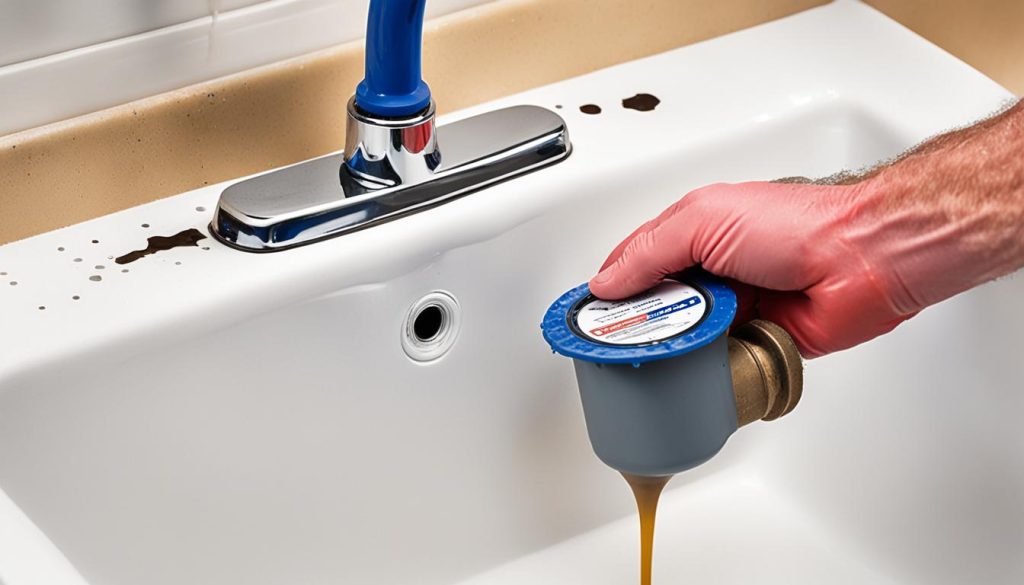Versatile Plumbers Putty Uses for Home Repairs
Did you know that plumbers putty, a humble product found in every DIYer’s toolbox, has a wide range of applications beyond plumbing? It’s true! Plumbers putty can be used for various home repairs, making it an essential tool for both amateurs and professionals alike.
Whether you’re fixing a leaky faucet, sealing a drain, or installing tiles in your bathroom, plumbers putty is your go-to product for reliable and long-lasting results. Its versatility and effectiveness make it a must-have for any homeowner or handyman.
Key Takeaways:
- Plumbers putty is a versatile product with numerous uses for home repairs.
- It can be used to fix leaky faucets, create watertight seals, and act as an adhesive for various materials.
- Plumbers putty is an essential tool for both DIYers and professional plumbers.
- It offers reliable and long-lasting results, making it a go-to choice for various repair projects.
- Using plumbers putty is a straightforward process that anyone can follow.
What is Plumber’s Putty?
Plumber’s putty is a versatile and essential product used in plumbing repairs and installations. It is a soft-set, pliable rubber compound that is primarily used for creating watertight seals in faucets and drains. Unlike other adhesives like silicone, plumber’s putty does not stick to the surfaces it is applied to, allowing for easy removal when necessary.
Plumber’s putty is commonly sold in small plastic tubs and is available in most hardware stores. It is a cost-effective solution for various plumbing applications and can be used on different materials including metal, granite, and fixtures.
Plumber’s Putty Definition:
Plumber’s putty is a rubber compound used for creating watertight seals in faucets and drains. It is a soft-set, pliable material that is easy to work with and offers reliable results.
| Key Features of Plumber’s Putty | Benefits |
|---|---|
| Easily removable | Allows for easy repair and maintenance |
| Waterproof seal | Prevents leaks and water damage |
| Works on various materials | Compatible with metal, granite, and fixtures |
| Highly versatile | Suitable for multiple plumbing applications |
When applied, plumber’s putty adheres to surfaces and expands when it absorbs water, creating an airtight seal. It is made by mixing elastomer and solvent, resulting in a jelly-like substance that hardens as it dries. This unique composition gives plumber’s putty its resistance to cracking, crumbling, hardening, and shrinking.
Plumbing professionals and DIYers alike rely on plumber’s putty for its durability, ease of use, and long-lasting performance. It provides a reliable watertight seal, making it an ideal choice for a wide range of plumbing repairs and installations.
How Does Plumber’s Putty Work?
In order to understand how plumber’s putty works, it is important to know its properties and composition. Plumber’s putty is a versatile and reliable material that is commonly used for sealing joints and preventing leaks in plumbing applications.
When plumber’s putty is applied between two surfaces, it adheres to them and creates a water-resistant seal. This seal prevents any liquids or gases from escaping, making it an effective solution for airtight plumbing connections.
The secret behind the effectiveness of plumber’s putty lies in its unique properties. It is composed of a mixture of elastomer and solvent, which combine to form a pliable and jelly-like substance. When this mixture comes into contact with water, it undergoes a chemical reaction that causes it to expand and harden.
This expansion and hardening process creates a tight and secure seal that is resistant to cracking, crumbling, and shrinking over time. Plumbers putty is known for its durability and long-lasting performance, making it an ideal choice for various plumbing fixtures and components.
Plumber’s putty can be used in a wide range of applications, including:
- Setting bowls
- Fixtures
- Faucets
- Sink frames
- Strainers
Its ability to adhere to different surfaces and expand upon contact with water makes it a reliable option for creating watertight seals in these plumbing installations.
How to Use Plumber’s Putty
Using plumber’s putty is a straightforward process that requires some basic preparation and a few simple steps. By following these instructions, you’ll be able to effectively use plumber’s putty to create watertight seals and complete your home repair projects with ease.
Step 1: Prepare the Surface
Before applying plumber’s putty, it’s important to ensure that the surface is clean and free of any previous putty, tape, or adhesives. Use a clean cloth to remove any dirt, debris, or moisture. This will help ensure a proper seal and enhance the longevity of the repair.
Step 2: Warm Up the Putty
Plumber’s putty can be quite pliable when warmed up. To make it more workable, simply warm your hands by rubbing them together or running them under warm water. This will soften the putty, making it easier to handle and shape.
Step 3: Shape and Apply the Putty
Take a small portion of the putty and roll it into a rope shape between your hands. Place the putty around the area you want to seal, such as a fixture or a drain opening. Press the putty firmly against the surface, ensuring it adheres securely. The putty should create a watertight bond, preventing any leaks.
Step 4: Install and Clean Up
Once the putty is applied, proceed to install the part or assembly as needed. For example, if you’re sealing a faucet, carefully insert the faucet into the mounting holes and tighten it securely. Remove any excess putty that may squeeze out during the installation process, and wipe away any residue with a clean cloth or sponge.
When to Use Plumber’s Putty
Plumbers putty is a versatile product that finds its best applications when a watertight seal is required. Here are some appropriate uses of plumbers putty:
- Around faucets to prevent leaks
- Around drains and sink strainers for a secure seal
- In plumbing components where watertight joints are needed
Not Suitable for:
- Plastic parts as it may cause damage over time
- Situations requiring adhesive strength
- Surfaces constantly underwater (e.g., bathtubs)
When used in the right applications, plumbers putty provides reliable and effective results, ensuring that your plumbing fixtures remain leak-free. Its pliability and ability to create watertight seals make it a preferred choice for DIYers and professional plumbers alike.
| Appropriate Uses | Not Suitable For |
|---|---|
| Around faucets | Plastic parts |
| Around drains and sink strainers | Situations requiring adhesive strength |
| In plumbing components | Surfaces constantly underwater (e.g., bathtubs) |
The Benefits of Using Plumbers Putty
When it comes to home repairs, plumbers putty offers a range of benefits that make it an essential tool for any DIYer or professional plumber. One of the main advantages of using plumbers putty is its ability to provide a reliable and long-lasting watertight seal. By effectively sealing joints, faucets, and drains, plumbers putty helps prevent leaks and potential water damage, giving you peace of mind.
Not only does plumbers putty offer excellent sealing properties, but it is also incredibly easy to use. With simple application steps that anyone can follow, you don’t need to be an expert to achieve professional-level results. Whether you’re a seasoned plumber or a first-time DIYer, using plumbers putty is a breeze.
Another benefit of plumbers putty is its pliability over time. Unlike other sealing materials, plumbers putty remains soft and flexible, allowing for easy removal if necessary. This feature is particularly useful when making adjustments or repairs down the line, as you can simply remove the putty without damaging the surrounding surfaces.
Lastly, plumbers putty is a cost-effective solution for your home repair needs. A small tub of plumbers putty often contains enough product for multiple projects, saving you money in the long run. When compared to other sealing materials, plumbers putty offers excellent value for its performance and versatility.
- Investing Wisely: How Windows & Doors in Boost Property Value and Financial Health - April 24, 2025
- The Financial Impact of Personal Injuries: Why Legal Help Matters for Business Owners - April 16, 2025
- The Hidden Financial Costs of Domestic Assault: What Business Owners Need to Know - April 16, 2025













